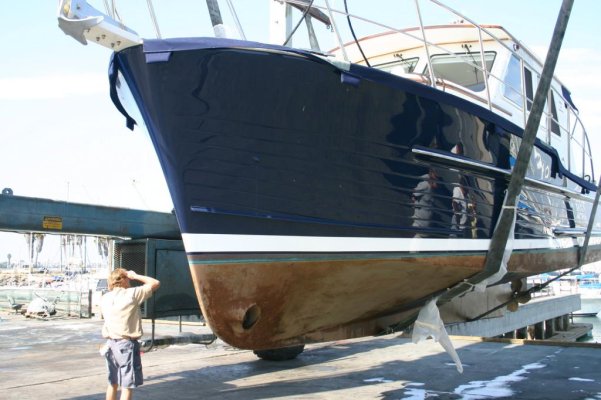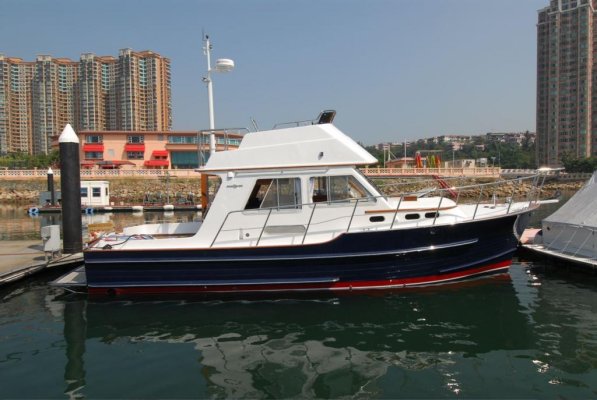boogiediver
Veteran Member
- Joined
- Oct 7, 2007
- Messages
- 80
I guess this comes under "general maintenance" since we are talking about gelcoat repair and hull painting (even though this boat is still in the hands of the builders). Sorry if you have seen this posted somewhere else, but I am trying to elicit opinions as quickly as possible.
Upfront, I know a lot of you are gonna be tempted to say: you <u>shouldnt</u> have chosen a blue hull, you <u>shouldnt</u> have ordered a new boat, and you <u>shouldnt</u> have ordered a new boat built in China. As Ive said before, I anticipated a testing time, it has been tough at moments, but we are pulling through nicely, and we are just days away from accepting what my surveyor and I consider to be an excellent little boat.
*
There is however one final outstanding (and significant) issue on which I would welcome your advice.
*
My hull has a blue Ashland gelcoat. When I saw the boat for the last time at the yard in China about 6 weeks ago, I saw no blemishes in the colouration of the gelcoat even in bright but slightly hazy conditions. Soon after she arrived in Hong Kong about 4 weeks ago, I saw her again - this time*on a clear blue sunny day. The sun was on the starboard side of the boat and, under those conditions, I could clearly see a patch of lighter coloured blue gelcoat about the size of a dinner plate (clearly visible in lesser lighting conditions as well). Bad news. As part of the builders final touch up works in Hong Kong (mainly a bit of teak and varnish work), the builder has undertaken to get some good people to repair that blemish with PU paint (still to be done).
*
I saw the boat again yesterday, this time with a mid-morning sun hammering down on the port side and, to my huge disappointment, there were 4 or 5 other areas of slight (much less obvious) discolouration, some bigger, some smaller, but all (but one) were invisible from a distance of more than 6-8.
*
If this boat had cost a lot more and was painted in a specialised climate controlled facility, then for sure one would expect the gelcoat job to be perfect. Instead, I chose a much more affordable boat (knowing of dangers of building in China), and I just dont have a sense of what degree of perfection in the gelcoat I should be expecting. Nor am I clear on what is the best course of action that I should be pushing for.
*
So here are some questions:
*
1)***** is some degree of minor discolouration (invisible beyond say 6-8) acceptable?
*
2)***** If there are only a few patches needing repair, is localized repair using Dupont PU paint an acceptable way to deal with it?
*
3)***** Do you agree that we only need to consider repainting the whole hull (with Dupont PU) if we have more than say 5 or 6 patches to fix? (bear in mind this is a 34 hull)
*
4)***** If I have the choice to try save the current gelcoat (which otherwise looks beautiful) or to paint the whole hull with Dupont PU paint, what would you suggest, and would I be disappointed with the PU paint finish (compared to the gelcoat finish)? In what way does PU paint not look as great as gelcoat?
*
I want to highlight that this boat is mostly great, and I am happy with the builders, and that the gelcoat generally looks fantastic from a little distance. Other than just one (maybe two) spots, you can really only see the colour blemishes close-up and when the sun is shining directly on it.
*
Would be grateful for you swift comments, as I will want to reach a decision with the builders by Wednesday so that works can be completed whilst I am away on vacation and so that we can finally take delivery in early January.
*
Many many thanks! Mark
Upfront, I know a lot of you are gonna be tempted to say: you <u>shouldnt</u> have chosen a blue hull, you <u>shouldnt</u> have ordered a new boat, and you <u>shouldnt</u> have ordered a new boat built in China. As Ive said before, I anticipated a testing time, it has been tough at moments, but we are pulling through nicely, and we are just days away from accepting what my surveyor and I consider to be an excellent little boat.
*
There is however one final outstanding (and significant) issue on which I would welcome your advice.
*
My hull has a blue Ashland gelcoat. When I saw the boat for the last time at the yard in China about 6 weeks ago, I saw no blemishes in the colouration of the gelcoat even in bright but slightly hazy conditions. Soon after she arrived in Hong Kong about 4 weeks ago, I saw her again - this time*on a clear blue sunny day. The sun was on the starboard side of the boat and, under those conditions, I could clearly see a patch of lighter coloured blue gelcoat about the size of a dinner plate (clearly visible in lesser lighting conditions as well). Bad news. As part of the builders final touch up works in Hong Kong (mainly a bit of teak and varnish work), the builder has undertaken to get some good people to repair that blemish with PU paint (still to be done).
*
I saw the boat again yesterday, this time with a mid-morning sun hammering down on the port side and, to my huge disappointment, there were 4 or 5 other areas of slight (much less obvious) discolouration, some bigger, some smaller, but all (but one) were invisible from a distance of more than 6-8.
*
If this boat had cost a lot more and was painted in a specialised climate controlled facility, then for sure one would expect the gelcoat job to be perfect. Instead, I chose a much more affordable boat (knowing of dangers of building in China), and I just dont have a sense of what degree of perfection in the gelcoat I should be expecting. Nor am I clear on what is the best course of action that I should be pushing for.
*
So here are some questions:
*
1)***** is some degree of minor discolouration (invisible beyond say 6-8) acceptable?
*
2)***** If there are only a few patches needing repair, is localized repair using Dupont PU paint an acceptable way to deal with it?
*
3)***** Do you agree that we only need to consider repainting the whole hull (with Dupont PU) if we have more than say 5 or 6 patches to fix? (bear in mind this is a 34 hull)
*
4)***** If I have the choice to try save the current gelcoat (which otherwise looks beautiful) or to paint the whole hull with Dupont PU paint, what would you suggest, and would I be disappointed with the PU paint finish (compared to the gelcoat finish)? In what way does PU paint not look as great as gelcoat?
*
I want to highlight that this boat is mostly great, and I am happy with the builders, and that the gelcoat generally looks fantastic from a little distance. Other than just one (maybe two) spots, you can really only see the colour blemishes close-up and when the sun is shining directly on it.
*
Would be grateful for you swift comments, as I will want to reach a decision with the builders by Wednesday so that works can be completed whilst I am away on vacation and so that we can finally take delivery in early January.
*
Many many thanks! Mark



